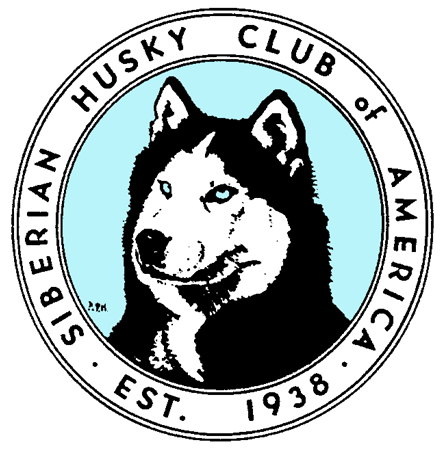Siberian Husky Polyneuropathy, Type 1
Siberian Husky Polyneuropathy 1, SHPN1, is a newly (2012) identified (along with and Shaking Puppy Syndrome 1, SPS1) neurologic disease of Siberian Huskies. It is a debilitating nervous system disease that impact an affected dog’s ability to walk. SHPN1 is a progressive disease that can severely change an affected dog’s quality of life.
History
Siberian Husky Polyneuropathy 1 (SHPN1) was first noticed in 2008 by a Siberian Husky breeder. At that time, it was felt to be an isolated incident and the sire and dam of the affected puppies were never bred again and the offspring were never bred as well. In 2012 another litter occurred and at that time the dedicated breeders, along with researchers, began an investigation into the cause of the disease. While the first known affected dog with SHPN1 was seen in 2012, the oldest carrier identified to date was born in the late 1990s.
Outreach from the original breeder and researchers found affected dogs to be occurring in other kennels and lines (both racing and show) in the US as well as in countries worldwide.
While researching SHPN1 the investigators noticed a subset of affected dogs that had similar, but different neurological signs that developed at an earlier age. Further research identified a different genetic mutation than for SHPN1 and the disease was named Shaking Puppy Syndrome 1 (SPS1).
Extensive testing was performed which included muscle biopsies, electrophysiological testing and testing for environmental factors which were ruled out. Testing was also performed to evaluate whether these diseases were the same as similar diseases – Alaskan Malamute Polyneuropathy (AMPN) seen in Alaskan Malamutes and Alaskan Husky Encephalopathy (AHE) seen in Alaskan Huskies – which concluded that SHPN1 and SPS1 are NOT the same as AMPN and AHE but are rather two newly identified genetic diseases of Siberian Huskies.
Signs
SHPN1 has a juvenile onset, affecting most dogs before they are two years of age. Signs can include gait abnormalities, loss of coordination (ataxia), muscle weakness and muscle atrophy with the hind legs being more affected. The disease is progressive and can lead to further inability to get around, muscle tremors and/or muscle contractures. SHPN1 affected dogs do not appear to develop laryngeal paralysis as is commonly seen in other causes of polyneuropathy. Severity of signs can be variable with some dogs only having mild signs and a fairly normal lifespan while others can be severely affected with associated poor quality of life and a significantly shortened life.
Videos of affected dogs can be viewed at Siberian Husky Health Panel | College of Veterinary Medicine
Research
Research was begun at UC-Davis College of Veterinary Medicine and, via collaboration, the research was continued at the University of Minnesota College of Veterinary Medicine. With new technology using genome wide DNA sequencing, the University of Minnesota College of Veterinary Medicine’s Canine Genetics Lab was able to identify the gene mutation responsible for SHPN1.
Based on current data, SHPN1 appears to be inherited in a simple autosomal recessive fashion which means that two copies of the gene are needed for signs to be shown. In addition, the SHPN1 gene mutation appears to have partial penetrance which causes variation in the severity and progression of the signs seen in affected dogs.
In February 2023 genetic testing became available for the two diseases.
Treatment
No treatment is currently available for SHPN1.
Testing
The University of Minnesota College of Veterinary Medicine’s Canine Genetics Lab offers testing for both SHPN1 and SPS1. Testing can be performed via check swabs, blood, semen and also dewclaw and tail docking samples. Submission forms, protocols, fees and shipping directions are available through the University of Minnesota College of Veterinary Medicine’s Canine Genetics Lab link at: Siberian Husky Health Panel | College of Veterinary Medicine. Test results are accepted by the Orthopedic Foundation of America (OFA) and will be listed on a dog’s health screening information page.
Testing is used to more definitively diagnose affected dogs and to aid in guiding breeding decisions.
Testing identifies whether the dog is CLEAR – is unaffected and carries no copies of the mutation. A dog tested clear cannot pass the mutation on to its offspring.
A CARRIER – is unaffected and carries one copy of the mutation. A carrier will pass the mutation to half of its offspring.
AFFECTED – is affected and carries two copies of the mutation. An affected dog will pass the mutation on to ALL of its offspring.
Testing can be done at any age and needs to be done only once in a dog’s lifetime.
Breeding Recommendations
The Siberian Husky Club of America highly recommends all breeding dogs be tested for both SHPN1 and SPS1 as only through testing can the production of affected dogs be prevented and the incidence of these diseases decreased.
Dogs tested CLEAR can safely be bred to any dog as they will not produce any affected dogs.
Dogs tested as CARRIER should only be bred to a dog tested CLEAR to prevent producing any affected offspring.
AFFECTED dogs should never be bred to another AFFECTED or CARRIER dogs as affected offspring WILL be produced.
PLEASE NOTE:
While an affected dog could be bred, it should only be undertaken with excessive caution and knowledge. ONLY a dog of extreme merit that is affected should be considered for this and should ONLY be bred to a CLEAR which will produce all CARRIER and no affected offspring. Breedings of these offspring should then follow the above recommendations.
Removal of CARRIER dogs from a breeding program is NEITHER NECESSARY NOR RECOMMENDED but rather CARRIERS can and should be bred in a knowledgeable manner as outlined above.
Webinar by Health & Genetics Chair Dr. Kevin Snyder, DVM, MS, Diplomate of the ACVO Board-Certified Ophthalmologist Shaking Puppy Syndrome, Type 1 (SPS1) and Siberian Husky Polyneuropathy, Type 1 (SHPN1) Education and SHCA Testing Requirements
version 12.24